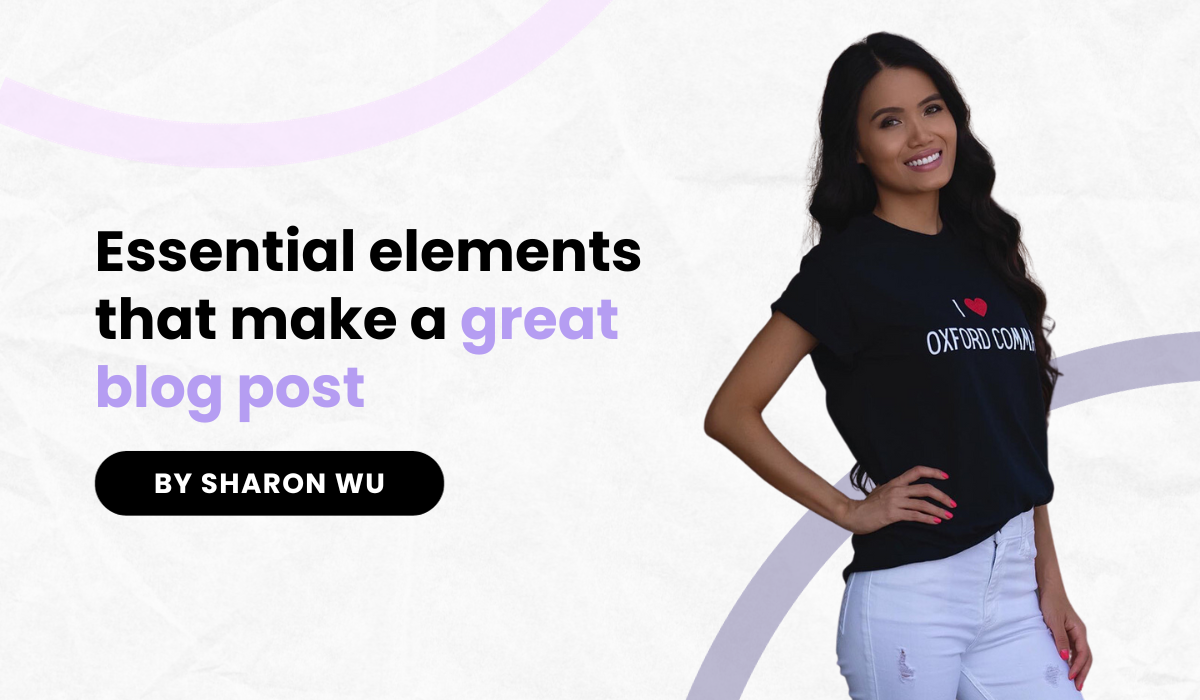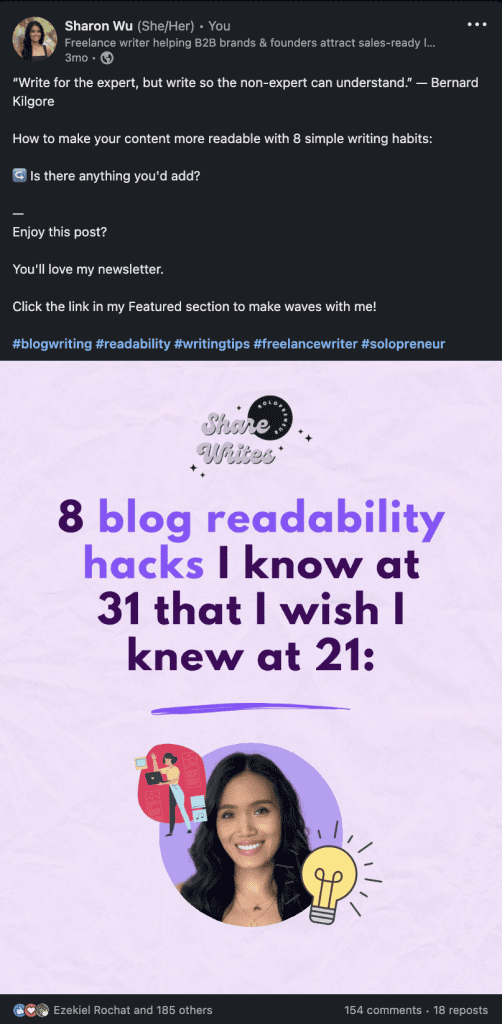Did you know 77% of Internet users read blogs?
It’s no secret blog posts are essential content marketing assets for businesses of all sizes. Through them, you can share your expertise with customers, build new relationships, and establish yourself as an authority in your industry.
B2Bs and B2Cs that publish quality articles reap major benefits, from boosting SEO to generating leads. But writing pieces that resonate with your audience requires effort and a solid strategy.
Want your audience — and search engines — to see your blog as an indispensable resource?
Let’s break down the 13 essential elements that make an exceptional blog post.
1. Open with an eye-catching featured image
A featured image draws people to your content by adding visual appeal. It helps readers understand what they’re looking at before reading any of the text.
There are two ways to source the perfect featured image for your blog post. If your business has custom photos, it would be best to use those. If not, there are plenty of resources where you can select stock images relevant to your blog post topics.
My go-to websites for quality stock images are:
I also like to use Canva Pro to design my own infographics. There are plenty of templates to choose from — so customizing to fit your branding is easy even if you’re not design-savvy.
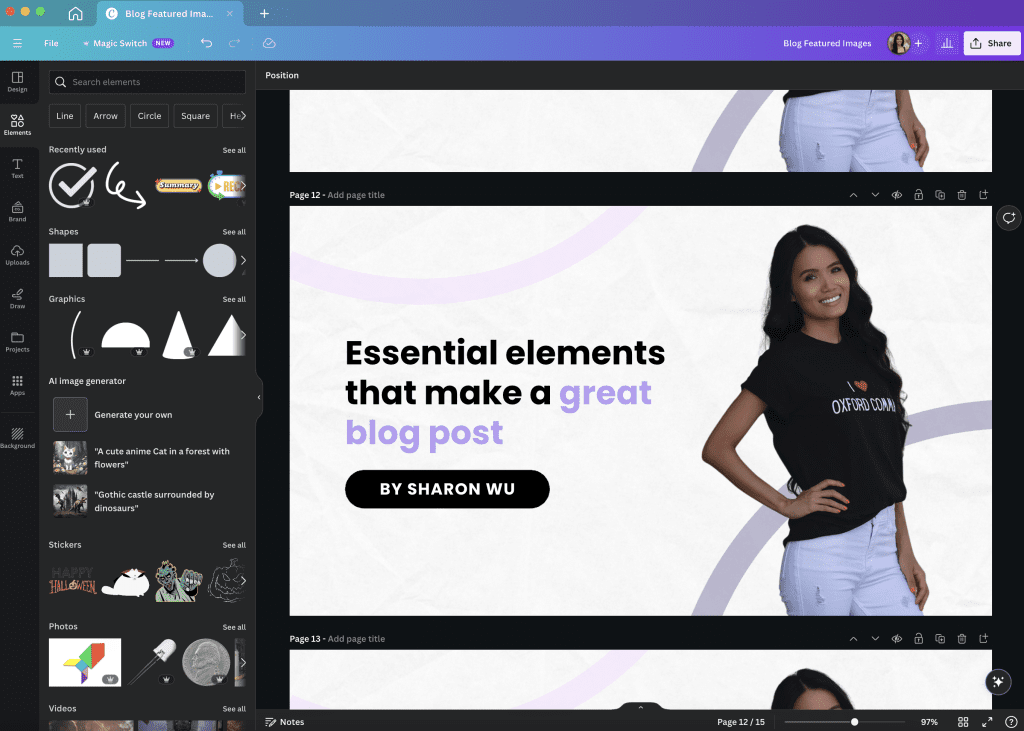
2. Grab attention with a compelling title
Your blog post title is the first thing readers see in search results. An intriguing title piques interest and urges people to click.
Keep titles concise — about 60 characters or less. The goal here is to get clicks — not cram in keywords.
An ideal blog title:
- Uses keywords organically
- Grabs attention with emotion or curiosity
- Clearly states the topic and focus of the post
Words like “how to,” “secrets,” “list,” “guide,” etc. work well for blog titles. Numbers also help titles stand out, like “10 Tips for X.”
Also, the best titles use power words. Power words appeal to readers because they evoke emotions and trigger curiosity. When a reader relates to what they see, they’re more likely to click and read more.
Here are some examples of headlines with excellent power word usage:
- 7 Hacks to Transform Your Cold Email Strategy
- Maximize Sales With These 5 Simple Techniques
Stumped on how to create a compelling title? Try these formulas and feel free to rearrange the components:
Numbers + Adjectives + Target Keyword + Promise
How To + Action + Without + Burden
You end up with something like this:
- 7 Easy Tactics to Master Content Marketing
- How to Boost Lead Generation Without Hiring More Staff
These formulas are good guides but don’t feel like you have to use them to a T every time. The goal is to get people interested, and then keep them engaged. Have fun with it!
3. Write an optimized meta description
The meta description gives readers a snapshot of what your post is about. This brief paragraph shows up under your title in search engines.
An effective meta description:
- Incorporates keywords naturally
- Inspires users to click with compelling copy
- Highlights the main focus and takeaways of the post
A meta description for a blog article about common SEO mistakes may look like this:
“Learn about the critical SEO mistakes to avoid or fix today if you want to rank on Google and be visible to prospective clients or customers.”
This is a great meta description because it:
- Is 141 characters – not too long or too short
- Has relatable words and language that evoke emotion and curiosity
- Suggests who the blog post is for (people who want to rank on Google)
- Includes relevant long-tail keywords: critical SEO mistakes, SEO mistakes to avoid
- Is actionable with the phrase “Learn about…” which encourages people to read more
4. Hook readers with an engaging introduction
Your opening paragraph needs to immediately capture attention. Address pain points your audience has or arouse curiosity with a thought-provoking statistic.
Here are impactful ways to open an article:
- Kick off with a compelling quote
- Pose a thought-provoking question
- Open with dialogue from an interviewee
- Highlight a common reader frustration or problem
- Reveal an intriguing statistic or fact about your topic
- Tell a brief anecdote or story exemplifying your theme
The goal is to capture interest right away while introducing the theme. Avoid generic openings like “Welcome to my blog on topic X.” Instead, be specific and tap into emotions like curiosity, surprise, or the desire for a solution.
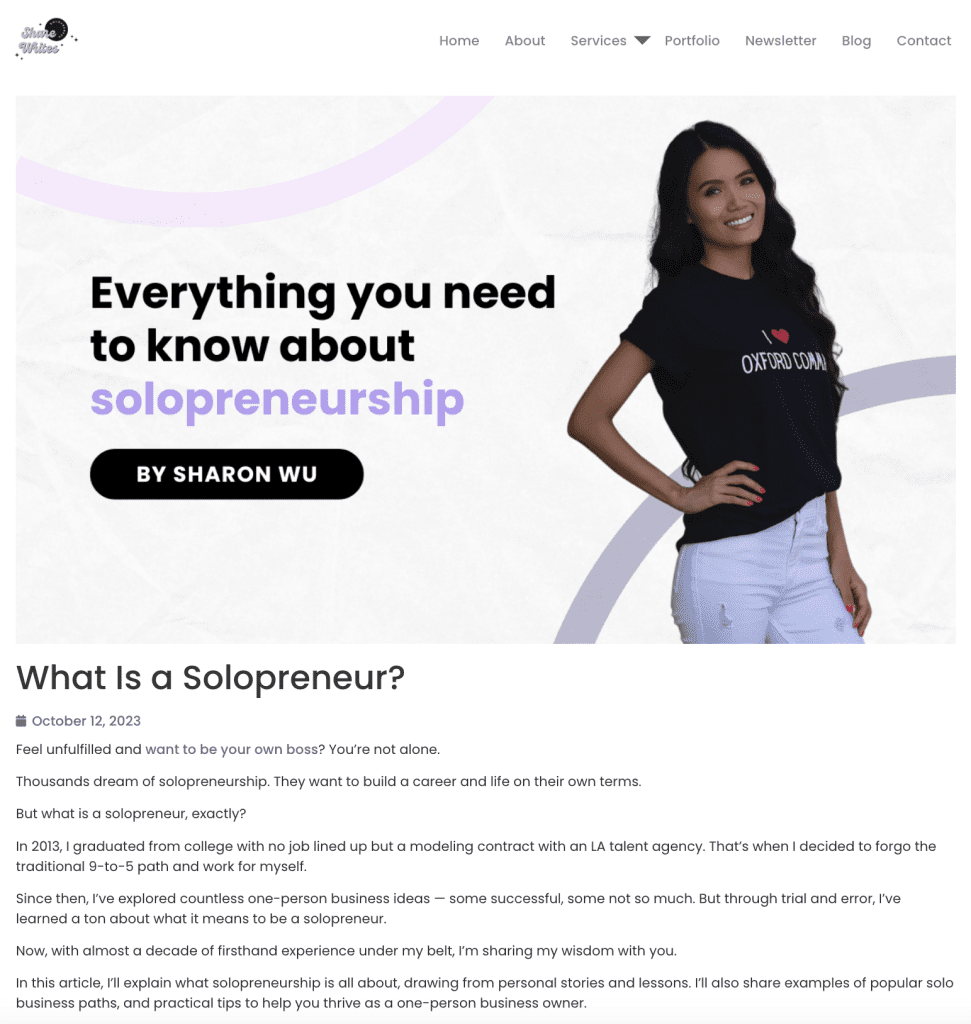
5. Break up text with interesting subheadings
Search engine-optimized blog posts vary in length and are often anywhere from 1,000-3,000 words. Regardless of length though, they must be easy to read.
Help your audience digest your content by using engaging subheadings throughout. This makes it easier for them to find what they are looking for quickly.
When coming up with subheadings, ask yourself:
- Does this make me want to keep reading?
- Do the subheadings reflect the body text below it?
- Does this break up text well and keep the blog post organized?
6. Add relevant images, charts, and multimedia
Visuals make content more engaging and memorable.
But choose wisely based on your goals:
- Charts/graphs to illustrate data clearly
- Infographics to simplify complex topics visually
- Photos and videos to connect on an emotional level
- Screenshots to demonstrate interfaces and features
- Diagrams/illustrations to show concepts or processes
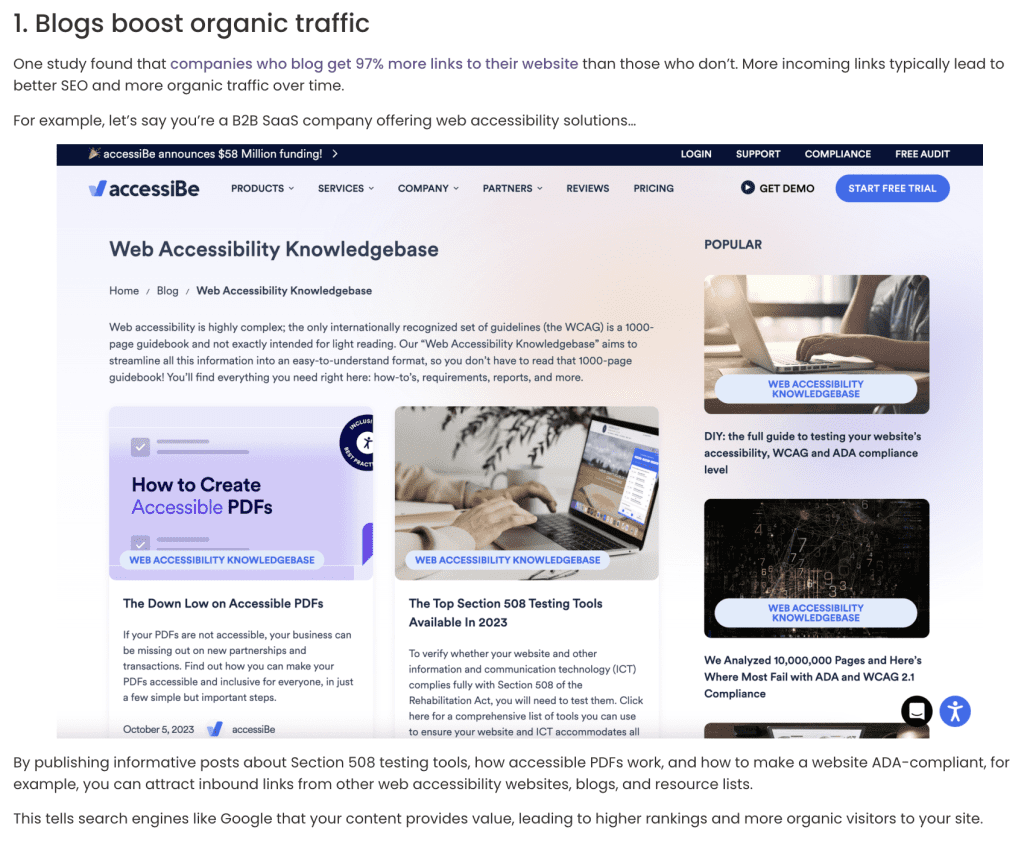
Whatever you choose, they should:
- Relate to your text
- Make sense for the topic
- Enhance the user experience
- Be properly optimized with alt text descriptions
7. Write customer-focused content
More often than not, people are looking for answers to problems when they visit blogs. So, your article should offer succinct solutions to these problems. Valuable content attracts more visitors and encourages them to return.
Avoid injecting too many ads into your posts because this can tarnish trust. Instead, use trending and evergreen topics to generate helpful information that people can use to make educated decisions.
Whenever possible, back up points with concrete examples — either from your own experiences or client testimonials. This builds credibility and helps readers visualize concepts.
For a post on small business marketing tactics, you may share a case study of how you helped an Etsy shop owner increase sales. Stats and expert insights also lend authority.
8. Optimize for SEO throughout
Optimizing your blog posts for SEO is paramount for driving organic traffic.
Here’s a quick checklist for you:
- Conduct thorough keyword research. Identify relevant keywords and long-tail variations people are searching for. Tools like Ahrefs and SEMrush are invaluable here.
- Organically incorporate keywords. Naturally work your target terms into headlines, subheadings, meta descriptions, image alt text, URLs, etc. Aim for a 1-2% keyword density. Don’t overstuff!
- Include semantic keywords and synonyms. Work in alternative words and phrases related to your topics to show relevancy. For example, a post on marketing automation may also include “campaign workflows,” “lead nurturing,” etc.
- Answer search questions. Analyze search data to find informational keywords and customer questions to address. If people are asking “how to start a blog,” make that your H2.
- Optimize surrounding content. Ensure other site pages linked internally have strong SEO as well, since Google indexes entire sites.
- Format content for scannability. Break up text with subheadings, numbered lists, and bullet points. Search engines favor skimmable content.
- Check mobile optimization. Make sure your site and posts render well on mobile devices since most search is now mobile-based.
- Link out to authoritative sources. This passes “link juice” and shows Google you create quality content.
- Limit promotional links. Don’t overload posts with self-serving links. Offer value throughout your content, not sales pitches.
With an SEO-optimized blog that answers customer questions, establishes expertise, and incorporates relevant keywords naturally, you gain immense power to rank highly and drive qualified organic traffic.
9. Incorporate internal and external links
Links are important for any blog post — they can keep your readers engaged and add value to your content.
There are two types of links that you should include in articles:
- External links are links to other websites and resources on the internet. Establish authority by pointing to other reputable sources that support your findings and statements.
- Internal links are links to other pages or posts on your website. When done correctly, they can help people get information quickly. Incorporating internal links is a strategic way to get eyes on different pages within your website and reduce bounce rates.
10. Make the next step clear with a strong call to action (CTA)
Every blog post should end with a call to action guiding readers on what to do next. This converts passive readers into email subscribers, social followers, or paying customers.
Calls to action aren’t limited to selling a product. Depending on your article’s goal, your CTA could be asking your audience to sign up for your newsletter or to follow you on social media.
Examples of strong call-to-actions include:
- Start your free trial
- Book a consultation
- Download the free toolkit
- Sign up for our newsletter
Remember: Make the CTA text a clickable button for higher conversion rates. Don’t make them second-guess where they should go!
11. Measure readability before publishing
A lot of people overlook readability, but it’s one of the most crucial aspects of any blogging strategy.
Before you hit ‘publish,’ measure your article’s readability and aim for an 8th-grade reading level or below. Grade 8 is a common benchmark for readability because it means people of most backgrounds and education levels will be able to digest your content.
If your piece is too difficult to comprehend, readers may get frustrated and leave. Write at an appropriate reading level so people stick around until the end of your article!
Pro tip: A quick and easy way to get a lower reading level is to simplify complex sentences and break up dense paragraphs.
12. Proofread for typos and errors
We’re all human, so mistakes happen. But they can undermine your expertise.
Always proofread thoroughly before publishing, or better yet, have someone else review. This catches typos, grammatical errors, inaccuracies, and other issues.
Pro tip: Download the Grammarly Chrome extension, which will identify errors (and suggest improvements) in your Google Doc as you write. I use the free version and find it suffices.

13. Add FAQs for extra value
An FAQ section (frequently asked questions) anticipates and answers common reader concerns. Tack this onto the end of posts to address doubts, objections, and knowledge gaps.
Besides demonstrating you care about helping readers beyond the scope of your main content, this is a great way to increase your chances of securing featured snippets on Google.
For example, a post about content writers vs. copywriters may include FAQs like:
- What’s the difference between content writers and copywriters?
- Should I hire a content writer or a copywriter?
- How much does a freelance writer cost?
Keep answers straightforward — try to answer the questions succinctly in 2-3 sentences.
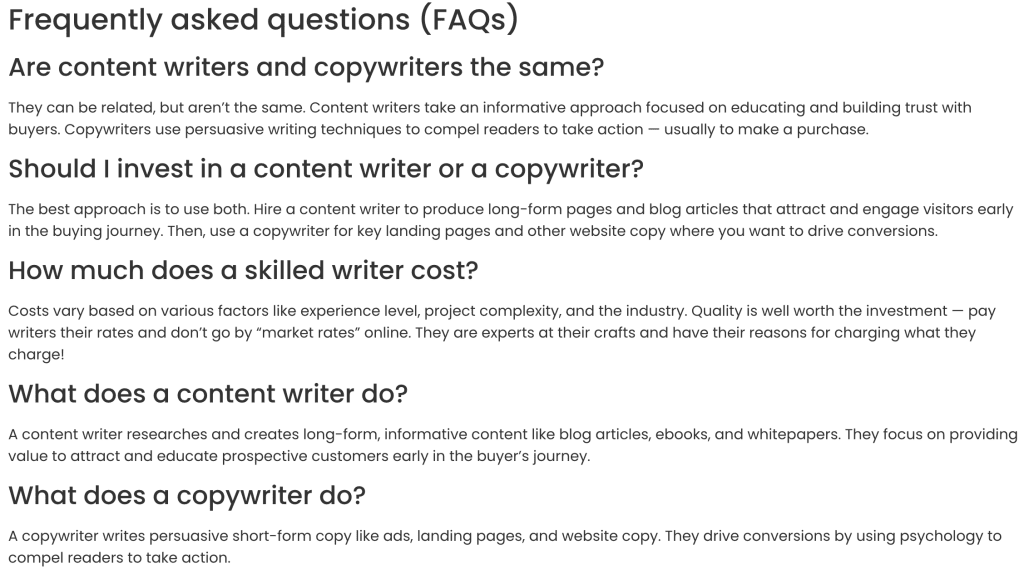
An effective blog post engages, informs, and converts
The foundation of a stellar blog post is just like any other good piece of content. It’s well-researched, easy to understand, and engaging at every turn. Elements like a compelling title, internal and external links, and a strong call to action help make your article stand out.
Having a robust blog is the cheat code for increasing ROI, building brand awareness, and getting more visitors to your website. Yet many businesses struggle to regularly publish quality posts.
Some common pain points include…
- Needing more research support
- Getting stuck for ideas and topics
- Lacking skills for expertly crafted content
- Having difficulty promoting content effectively
- Finding time for ongoing blogging amidst other priorities
Sound like you?
Consider delegating blog writing to a professional. I’m a freelance content writer specializing in long-form articles. With almost a decade of experience writing blogs across diverse industries, I excel at thoroughly researching and producing posts optimized for your audience and goals.
Let’s chat about taking your content marketing to the next level. I’m eager to learn about your business and work together to create blog content that converts.
Frequently asked questions (FAQs)
How long should a blog post be?
Aim for at least 1,000 words or more — posts under that tend to rank lower on SERPs. In-depth content ranks well for competitive keywords, but make sure you’re providing value and not fluff to meet a word count. Conduct a Google search for your target keyword to get an effective ballpark range for word count based on your competitors’ top-ranking articles.
How many visuals should I have in a blog article?
There’s no magic number but aim for at least one relevant visual per 350 words. Break up text frequently with related graphics, charts, photos, and videos.
What’s the ideal keyword density for a blog post?
1-2% keyword density is ideal for a blog post. Mention keywords naturally without overstuffing. Include variations like long-tail keywords, too.
How do I come up with blog post topics people care about?
Research keywords by referring to Google’s “People Also Ask” section, Ahrefs, and social listening. Look for questions people are asking online related to your business. Then, identify knowledge gaps and address them with helpful, detailed posts.
How do I make my blog more readable?
To strive for grade 8 reading ease or below, use short paragraphs with 2-4 sentences. Write in active voice and a conversational tone. Visuals and multimedia can be great for breaking up text and creating a more interactive experience.
This article was originally published on LinkedIn, but updated on 10/23/2023.

